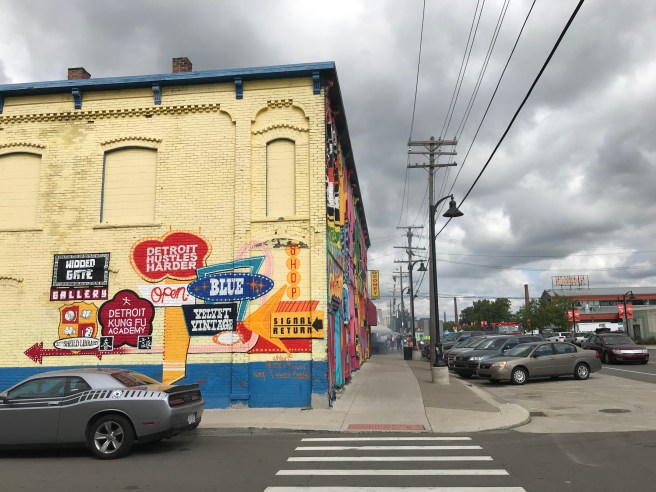
A couple of weeks ago, my partner and I traveled to Michigan to reunite my sister with her cat, Iwashi Oda. Iwashi had been living with us for a little over a year whilst my sister lived in Kyōto. It was my first time back in the Middle West in several years and during our visit, we explored not just Ann Arbor (where my sister lives) but also some of the small towns outside, including Dexter and Saline. We (minus Iwashi) also spent a day in Detroit, a city that I’d never been to except for a single layover at Detroit Metro Airport… which is actually in Romulus.
When I was growing up in Missouri in the 1980s, most of my travels (save for those to relatives in Iowa) took me further south and I didn’t really explore the Midwest proper until I was in college. I don’t recall ever really considering a trip to Detroit back then nor did it often cross my mind. I do remember that in my elementary school there was a student who’d moved from Detroit. He fully promoted the idea that having survived Detroit (for his eight or nine years, mind you), he could survive anything. However, as I recall, he also seemed suspiciously country — wearing as he did his ginger hair in a center-parted “butt-cut” paired with the then de rigueur (in the country) rat tail. I can’t help but wonder whether or not he was actually from somewhere outside Detroit… like Romulus.
On the flight to Detroit, I found myself wishing that there had been films available for viewing filmed in or at least set in Detroit. There were none. By contrast, when I flew to Tokyo, I was able to enjoy the classic Tokyo Story on the flight. I suppose that’s the sort of detail you’d expect from a Japanese airline and not an American one, where most of the film catalog consisted of both Hollywood-produced animated children’s films and Hollywood-produced quasi-animated children’s superhero films.
Anyway, if one wanted to watch a Detroit film before visiting, I would suggest Gran Torino, Darkman, and especially Robocop (although it’s mostly filmed in Dallas). Detroit movies which I haven’t seen — but would’ve watched had the airline featured them — include The Betsy, Blue Collar, Detroit 9000, Mickey One, Scarecrow, and Traveling Husbands. Instead, I watched American Graffiti, which is set in Modesto but at least is sort of car porn.
Detroit remains closely associated with cars and its best-known nickname remains “Motor City.” In the unlikely event that someone utters “Arsenal of Democracy,” “City of the Straits,” “Hockeytown,” or “The Paris of the Midwest,” those, too, are apparent nicknames of the city. For a long time, however, Detroit is itself a sort of byword for urban decay. In fact, its infamy is so great that tourists from Europe routinely visit the city in search of ruin porn and little else. I too found no shortage of abandoned buildings, and I too find that they have an almost irresistible photogenic quality — and yet I also felt a strong sense of both resiliency and vibrancy which photos of crumbling factories and rotting mansions fail to convey.
As of the last census, the population of Detroit was still in decline but that decline is slowing and it will be interesting to see what the next census, undertaken next year, reveals. Whatever the case may be, Detroit is still, by American standards, a big city. It’s the biggest city in Michigan, the biggest city on the US-Canada border, and Metro Detroit — home to 4.3 million people — has the second largest population and economy in the Midwest — after Chicago. Detroit also attracts 19 million visitors, and I assume that the majority of them come not to photograph ruins but to visit family and friends, for work, or to check out the city’s museums, architecture, &c.
What’s now Detroit has been occupied by humans for at least 11,000 years. The original inhabitants were likely the Paleoamerican moundbuilders whose demonym, assuming they had one, has been erased by the passage of time. By the time Europeans entered the region, it was home to the Huron, Iroquois, Odawa, and Potawatomi nations.
In 1701, Antoine de la Mothe Cadillac there founded Fort Pontchartrain du Détroit. The name, Détroit, was derived from “le détroit du lac Érié” or “the strait of Lake Eerie.” In order to attract settlers to the area, France offered free land. By 1765, the settlement’s population reached 800 and Détroit’s economy revolved around the trade of beaver fur. By 1778, when its population reached 2,144, Détroit was the third largest settlement in Quebec.
In 1760, the British gained control of Détroit (and presumably dropped the “accent aigu”). By the early 1800s, Anglo-Americans outnumbered Franco-Americans — although there still exists in the region a subculture of so-called “Muskrat French.” Most of old Detroit burned to the ground on 11 June 1805. On 30 June, however, the Michigan Territory separated from the Indiana Territory and Detroit was designated the new territory’s capital. Chief Justice of the Michigan Territory, Augustus P. Woodward, and Governor William Hull collaborated on a new street plan for the decimated city based around wide radial avenues extending outward from Grand Circus Park.
Michigan became a state in 1837 and ten years later, the capital of Michigan moved from Detroit to Lansing. Detroit remained an important city for several reasons. It was a major hub on the Underground Railroad, through which many slaves escaped into neighboring Canada. It was also an important hub of shipping, shipbuilding, manufacturing, and transportation. Rapid economic growth fueled the so-called Gilded Age when magnates and barons of industry and shipping built beautiful mansions for their families. Woodward Avenue, in particular, and in the neighborhoods east and west of Downtown were especially popular with the city’s economic elite.
Industrialist and a business magnate, Henry Ford, abandoned the family farm to find work as a machinist in Detroit. Shortly after he opened his first automobile shop on Mack Avenue and in 1903, founded the Ford Motor Company. His lead was followed by William Crapo “Billy” Durant (co-founder of General Motors with Frederic L. Smith and co-founder of Chevrolet with Louis Chevrolet), John Francis and Horace Elgin Dodge, James Ward and William Doud Packard, and Walter Chrysler. Detroit thus arose as the primary hub of American automobile manufacturing.
Detroit’s population grew and in the 1910s, it rocketed past Pittsburgh, Baltimore, Cleveland, Boston, and St. Louis to become the nation’s fourth most populous city. It maintained that position until the 1940s when it was overtaken by Los Angeles. The Great Migration brought many Appalachians and other Southerners — both black and white — into the city. At the same time, large numbers of Catholics and Jews immigrated to the city from Eastern Europe and the Levant. The then long-dormant domestic terrorist organization, the Ku Klux Klan, was revived in the 1910s and ’20s and was quite active in Detroit. In 1943, the Detroit Race Riot erupted — one of several race riots that occurred in the US during World War II.
Detroit’s population began to decline in the 1950s, when, aided by newly constructed freeways, many white Detroiters abandoned the city for its racially-and-economically exclusive suburbs. At the same time, redlining and public disinvestment degraded the standard of living for those who remained in Detroit. Detroit was rocked by another race riot in 1967. The decision of the court case of Milliken v. Bradley, in 1970, further entrenched Detroit’s racial segregation.
In the 1970s, Detroit became a black-majority city. The city’s first black mayor, Coleman Young, was elected in 1973. The gasoline crises of 1973 and 1979 made American motorists more mileage conscious but stubborn American automakers doubled down on fuel-inefficient models. Consumers, naturally, responded by abandoning American cars in favor of fuel-efficient German and Japanese brands. Rather than give Americans what they wanted, American automakers fired thousands of autoworkers and began relocating manufacturing plants to Mexico so that they could pay autoworkers less but still appeal to “patriots” and simultaneously stoke hostility against Japanese (and by extension, all Asians) by advertising their products as being “Made in North America.”
As jobs vanished, crime flourished, with homicides peaking in 1974. In 1982, a Chrysler plant supervisor, Ronald Ebens, and his stepson, laid-off autoworker Michael Nitz, beat to death Detroiter Vincent Chin. Chin (who worked as an industrial draftsman at Efficient Engineering, as an automotive supplier, as well as a waiter at Golden Star) was born in Highland Park, Michigan but was attacked by his murderers because they were angry about increased sales of Japanese cars. Ebens and Nitz were subsequently found guilty of manslaughter but neither served even a day of jail time.
Detroit wasn’t the first major American city to undergo population loss following significant economic turmoil, preceded as it was by Philadelphia, Cleveland, St. Louis, and Boston. Only St. Louis’s population decline was more dramatic than Detroit’s, though, and in 2013, Detroit became the largest American city to file for bankruptcy. That said, there’s a sense, in some quarters, that Detroit may be on the verge of a renewal of sorts. The homicide remains high but pretty far below number two Baltimore and number one St. Louis. Detroit’s homicide rate, meanwhile, peaked all the way back in 1991.
Optimistic Detroiters point to several projects as signs of positive change. The first phase of the ongoing Detroit International Riverfront project opened in 2001. Campus Martius, a popular public space, opened in 2004. The Port Authority Passenger Terminal opened in 2011. Little Caesars Arena, the new home of the Detroit Red Wings and Detroit Pistons, opened in 2017. The city exited bankruptcy in 2014. The Arnold Home, the Mark Twain Branch Library, and Tiger Stadium were all demolished — but the formerly-derelict Book Cadillac Hotel, David Broderick Tower, David Whitney Building, Fort Shelby Hotel, Michigan Central Station, and the James Scott Mansion have all been renovated. Renovation is also planned for the infamous Packard Automotive Plant. On a smaller scale; urban farming, prairie restoration, and organizations like Detroit Blight Busters, Farm City Detroit, Detroit Guerrilla Gardening Action Network, and others have transformed, improved, and re-purposed derelict buildings and lots.
That said, even Downtown and Midtown, which have apparently seen population increases in recent years, are sometimes startlingly quiet to someone accustomed to more bustling cities. The hulking, half-demolished Joe Louis Arena and potholes capable of swallowing small cars remind you that even these rebounding areas have a long way to go and even the shiniest corners of Downtown felt strangely empty — although that could owe as much to the city’s low-density, auto-oriented sprawl as to its underpopulation. What’s more, many of the streets are inhumanely wide. Pedestrians, one gets the sense, would be rarer here than in most cities even if the population tripled.
EASTERN MARKET

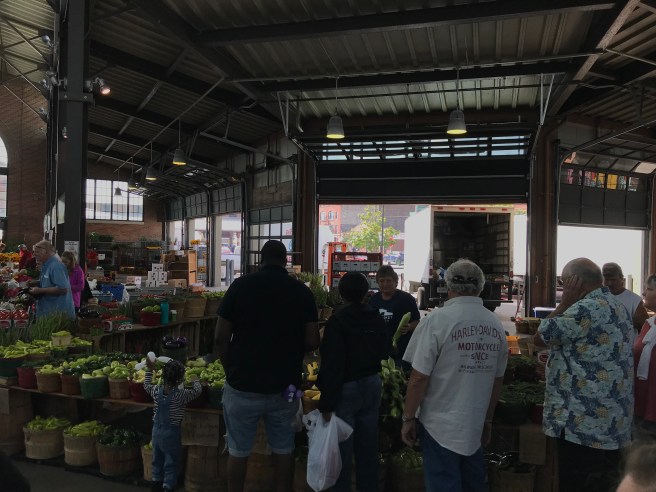
We started our day in Detroit at the Eastern Market — which proved to be the exception to Detroit’s characteristic emptiness. Eastern Market is full of vendors selling food, flowers, art, and artisanal products. The area around the market is full of new, colorful murals. It was also positively packed with people of various backgrounds and ages. My sister bought a beignet. I bought a breakfast burrito. It has been in operation at that location since 1891. It is apparently both the largest historic public market in the US and the largest open-air flowerbed market in the US.
RIVERFRONT
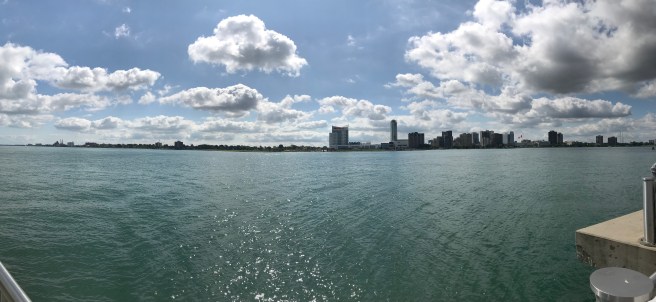
We next headed to the Detroit Riverfront. The Detroit River is short but wide, connecting Lake St. Clair in the north with Lake Eerie in the south. Across the river is Windsor, Canada. It is one of just two in the contiguous US at which Canada is located south of the US. Given the relative emptiness of the area, accessing the river seemed to me to be needlessly complicated. We entered and exited several empty parking lots be only to be rebuffed by pointless fences and barriers. Eventually, we able to access the waterfront. The river, flowing as is does between two largish cities — appeared to be rather unpolluted — the result of decades of ecological restoration, clean-up efforts, and regulation. We didn’t linger long, however, because behind us beckoned one of Detroit’s most recognized icons.
RENAISSANCE CENTER

The Renaissance Center was built in 1977 as part of an effort to attract wealth and investment back to Downtown. Una noted the resemblance of the seven interconnected skyscrapers to Los Angeles’s Bonaventure Hotel and I pointed out that the principal architect for both was John Portman. The shiny, late modern structure was completed a year after the Bonaventure and was then the world’s tallest hotel. It is unmistakably a product of the 1970s, a decade in which many architects seemed to place their dreams for the future in self-contained arcologies — essentially self-sustained cities within cities. Today such futuristic postmodernism strike one as unmistakeably retro and most urbanists now imagine a future in which buildings and their surroundings are less fortresslike and more integrated.
Inside the Renaissance Center looks quite a bit like the Bonaventure, albeit weirdly littered with cars. The balconies of both could be described, without undue pretense, as “seating pods.” The overall effect is of a maze built within a panopticon. It is now home to General Motors, though, who’ve transformed the ground floor into the GM World exhibit. Hideous cars and trucks are displayed as if deposited in the lobby by floodwaters. Meanwhile, selfie stick-wielding, bling jeans-wearing husbands corrall their wives and children in order to commemorate their visits to GM World with photos it is just as unlikely anyone will appreciate as it is that any of these off-road will ever be driven off-road.
When a city as old and large as Detroit is decidedly less-walkable than Los Angeles, something remains glaringly and deeply wrong. A 2016 study found that 24.7% of Detroit households lack a car. Even in households with a car, most are used by a single adult at a time. 23.7% of Metro Detroiters commute more than 80 kilometers (50 miles) for work. According to Curbed Detroit, Metro Detroit spends $69 per capita on transit each year. Cleveland, by comparison, spends $177; Seattle $471. At the same time, Michigan has the costliest car insurance rates in the US.
Detroit was not always so underserved by mass transit. The first horse-car trains entered service in 1863. The system was fully electric by 1895. The privately-owned Detroit United Railway (DUR) operated a network of streetcars and interurban trains from 1900-1928. Its last interurban line ceased operation in 1931. The publically-owned, city-operated Department of Street Railways (DSR), which had taken over the streetcar network, began selling it off and converting to bus routes, discontinuing the last in 1956 — finishing off the last vestiges of the city’s once impressive 859-kilometer streetcar network. The DSR became the Detroit Department of Transportation (DDOT), in 1974, operates a fleet of buses along 43 routes. Detroit launched the Detroit People Mover in 1987. It moves along a short (some might say, walkable) loop of just 2.94 miles (4.73 km) and operates at a cost per passenger mile that’s more than five times the cost per passenger mile of a bus. It was originally intended to be part of a city-wide light rail transit system but that was never built and, instead, the following year Amtrak service to Michigan Central Station was abandoned. The Beaux-Arts train station, built in 1914, was once one of the grandest train stations in the country. After it’s closure in 1988, it stood abandoned for nearly 30 years, a tangible symbol of declining investments in public infrastructure.
Michigan Central Station was replaced, in 1994, by Detroit Station (also known as Baltimore Street Station), a modest intermodal transit station also served by Greyhound, DDOT buses, and the city’s QLine, a single streetcar line that connects Amtrak to the People Mover. The inauguration of an Ann Arbor–Detroit commuter rail service, MiTrain, scheduled to begin operation in 2022, will likely be even more transformative. Once in operation, that train will connect Ann Arbor via Dearborn, Wayne, and Ypsilanti.
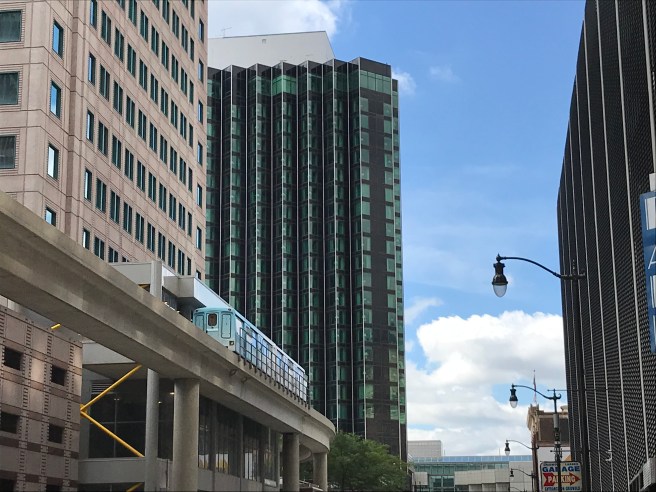
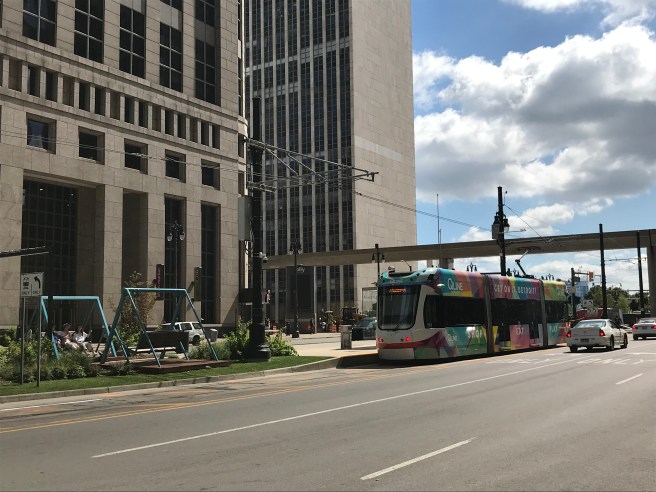
GUARDIAN BUILDING
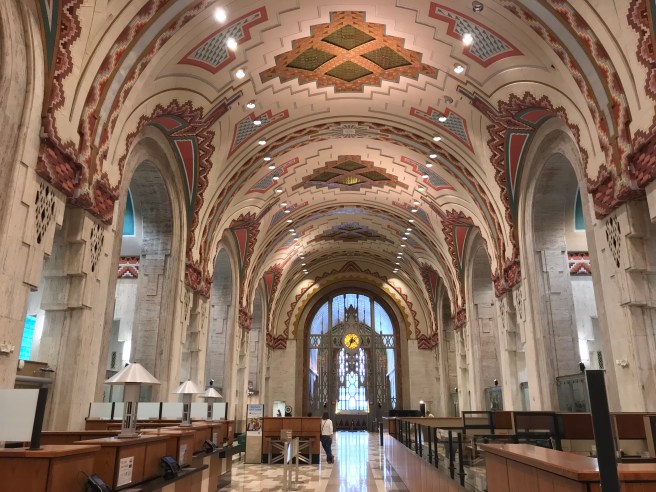
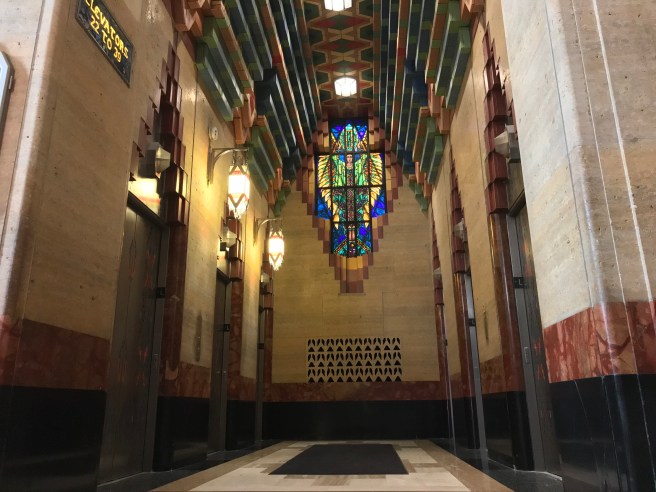
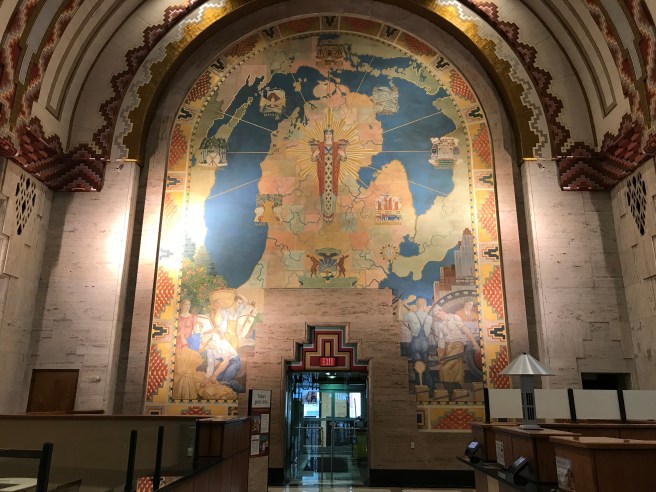
We saw buses, the People Mover, and QLine but opted to walk to our next destination, the Guardian Building. The Guardian Building is an Art Deco skyscraper completed in 1929. It was designed by local architect Wirt C. Rowland, who designed several of Detroit’s most prominent structures. The architectural sculptures were designed by Corrado Parducci. The building’s exterior is nice but the real magic is in its interior — specifically its lavish, three-story, vaulted lobby, decorated with Rookwood and Pewabic tile (the latter from Detroit’s own Pewabic Pottery studio), some of which seem to glow. It is unreal — not only very clearly not of this era but, it almost seems, not of this world.
VEGAN SOUL
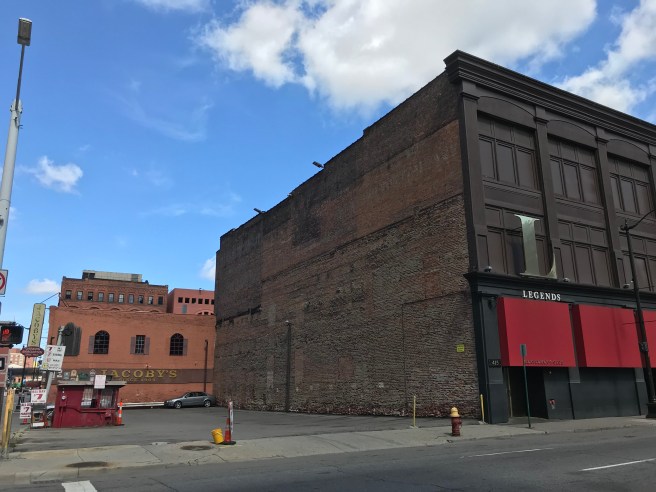
As much as I love to sit and appreciate architecture and design, it is not enough to sustain one and when Una and my sister let me know that they were getting “hangry,” we walked back to my sister’s car. Although the distance was less than three-quarters of a mile, thanks to the lack of shade, acres of surface parking lots, and freeway-like nature of Jefferson Avenue, it felt decidedly longer.
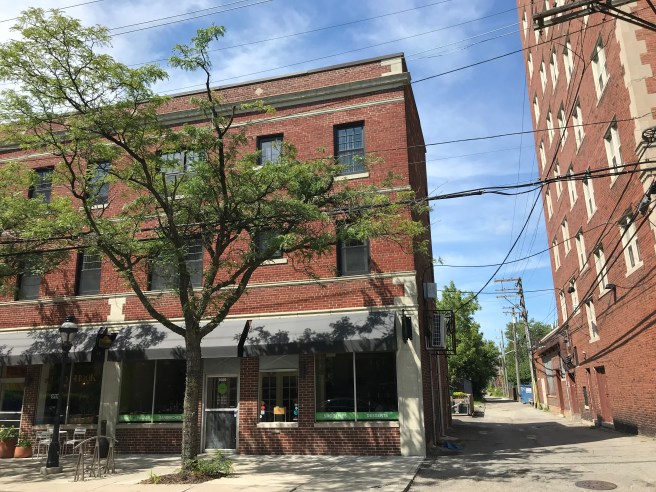
For lunch, we headed to Detroit Vegan Soul, the straightforward name of which lets you know exactly what to expect. It’s located in the West Village neighborhood, which takes its name — as does the East Village — from it’s geographic relation to the better known Indian Village neighborhood. In the first half of the 20th century, all three were upper-class neighborhoods which counted among their residences several prominent architects, politicians, and businessmen. The stately mansions are built in a variety of mostly revival styles, including Colonial Revival, Federal, Georgian Revival, Prairie School, Queen Anne, Renaissance Revival, Spanish Colonial Revival, and Tudor Revival. Needless to say, they were long ago abandoned by the toffs and some are a little worse for wear. More, however, look as good if not better than ever, the once small seedlings of their yards having reached majestic maturation.
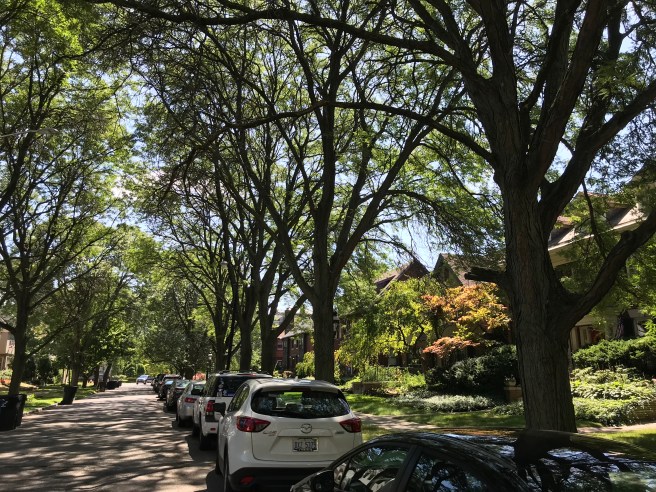
The servings at Detroit Soul are hefty — it is exceedingly rare that I cannot eat all of my food plus the leftovers of my companions. However, I found myself overcome by heaps of delicious black-eyed-peas, cornbread, mac-n-“cheese,” glazed sweet potatoes, and smoked collards.
Our next destination was to be the Motown Museum, for which we’d reserved tickets the day before. As I struggled to retain my membership in the “Clean Plate Club,” my thoughts turned to Detroit’s other great music: techno. As important as Motown is, no one city can rightfully claim to be the birthplace of soul music. Techno, however, is another story. When I was in my early teens, I discovered Krafterwerk and acid house music so it was only natural that I would develop an appreciation for Detroit’s futuristic pulse.
A Number of Names, Audio Tech, Blake Baxter, Carl Craig, Channel One, Chrome, Circuit Breaker, Concept 1, Cybotron, Derrick May, Drexciya, Eddie ‘Flashin’ Fowlkes, F.U.S.E., Forcept 1, Hard Trax, Inner City, Intercity, Jack Master, Jeff Mills, Juan Atkins, Kevin Saunderson, Keynotes, Kreem, “Mad” Mike Banks, Model 500, Plastikman, R.H.X., Reese & Santonio, Rhythim Is Rhythim, Richard Michaels, Robotman, Spark, Suburban Knight, Triple XXX, UP!, Underground Resistance, Xenon, and X-Ray may not be household names in the way that most of the Motown roster are — but to techno fans they’re all legends… and all are from the Detroit area. I took a stab in the dark and performed an internet search for “Detroit techno museum.” Lo and behold, I turned up an article in Metro Times about just such a place, called Exhibit 3000.
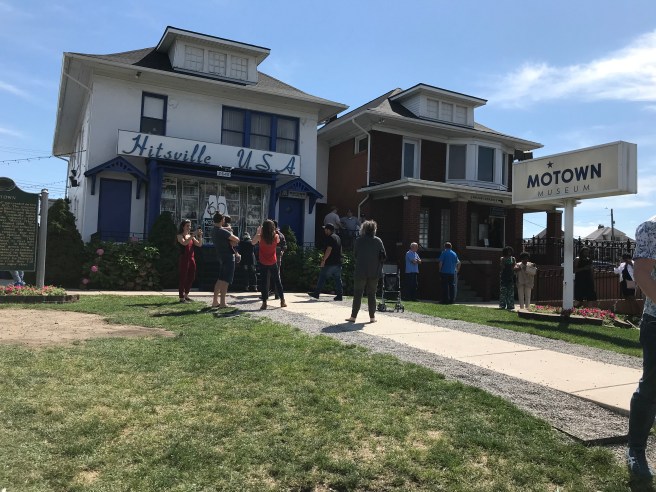
But first, it was off to the Motown Museum. All tours are guided, for specific times, and often sell out and so getting tickets beforehand is advised. Other than the automobile industry, probably no Detroit business is better known than Motown Records. That label was founded (as Tamla Records) by Berry Gordy Jr. in 1959 and was home to soul and R&B superstars like Diana Ross & the Supremes, The Four Tops, The Jackson 5, The Marvelettes, Marvin Gaye, Smokey Robinson & The Miracles, Stevie Wonder, The Temptations, and many others. The songwriting team of Holland-Dozier-Holland and the group of studio musicians known as the Funk Brothers produced the bulk of the label’s more than 100 Top Ten hits (although I’ll be damned if you never hear more than the same dozen or so on any oldies station today).
I didn’t know what to expect beforehand and was pleasantly surprised that the museum is located inside Tamla/Motown’s first headquarters, nicknamed Hitsville U.S.A., and Gordy’s former residence/office/studio. It became the Motown Museum in 1985. There’s a gift shop inside, now, too. Music was bumping as we parked the car, and the smell of food cooking and incense filled our nostrils as we approached. People wandered the grounds. It all felt pretty informal — in our case almost to a fault — thanks to a loud, obnoxious, couple who reeked of booze and were clearly out of their heads. Anyway, aside from them it was enjoyable and educational. I didn’t realize that Berry Gordy had so many other imprints (e.g. Chisa, Divinity, Gordy, Hitsville, Manticore, Mel-O,Dy, Melodyland, Miracle, MoWest, Prodigal, Rare Earth, Soul, V.I.P., and Workshop Jazz).
And, it has to be mentioned, there were other Detroit soul labels (e.g. Boss Records, Carla Records, Golden World Records, Impact Records, Inferno Records, Karen Records, Moira Records, Revilot Records, Ric-Tic Records, Ruth Records, Sir-Rah Records, Sports Records, Tri-Phi Records) and Detroit Soulsters who never recorded for Motown (e.g. Aretha Franklin, The Dramatics, Jackie Wilson, and Ray Parker, Jr.,).
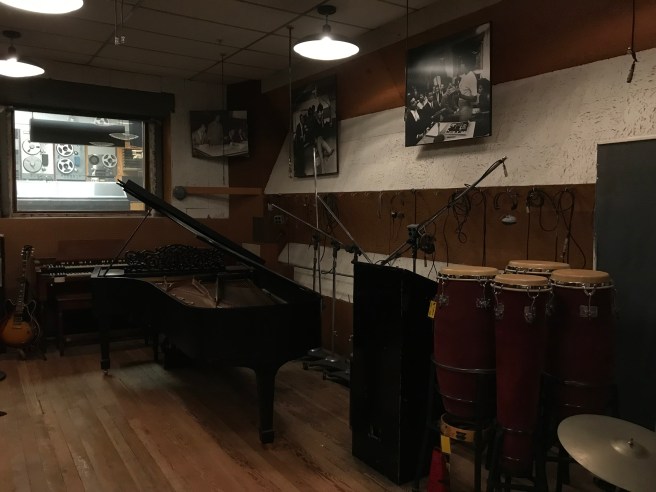
The tour includes a gift shop where one can buy all sorts of Motown souvenirs. My favorite parts of the tour, though, were Berry Gordy’s upstairs apartment — roped-off but decorated to appear as it did in the 1960s — and Studio A. I don’t normally get moved by historic battlefields, celebrity cemeteries, and that sort of thing but this was different, imagining myself leaning against a wall where a young Smokey Robinson no doubt leaned many times.
FISCHER BUILDING
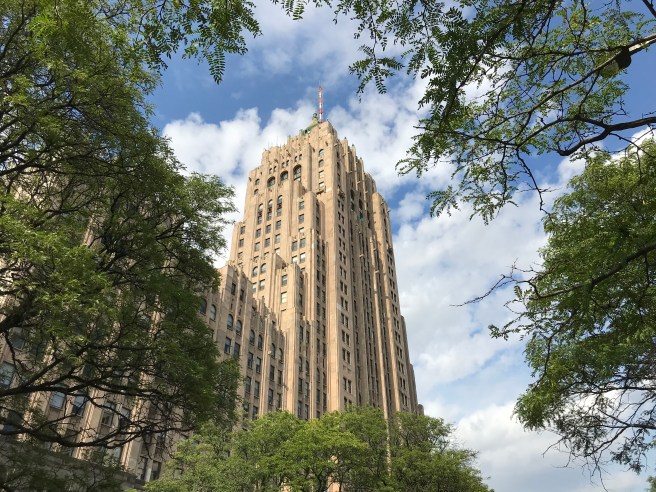
After the Motown Museum, we headed over to the Fisher Building, nearby in New Center, a neighborhood that I learned is an historic district located in Uptown Detroit developed in the 1920s as a sort of edge city. Its location was chosen due to its convenience to both Downtown Detroit and the outlying factories. Although it felt to me very much a part of Detroit, it retains the distinctness of a thriving community absorbed into another.
The Art Deco-syle Fisher Building was designed by Albert Kahn and completed in 1928. It was financed by profits from the sale of Fisher Body to General Motors. Apparently, back in the day, Frederick, William, Lawrence, Edward, Alfred, and Howard — the Fisher Brothers — essentially developed the bodies for early horseless carriages. Inside the beautiful building is the 2,089-seat Fisher Theatre. Shortly after we arrived, the theater emptied and an audience of people in semi-formal wear — in many cases wearing cat ears — exited a performance of a musical, which not surprisingly, turned out to be Cats.
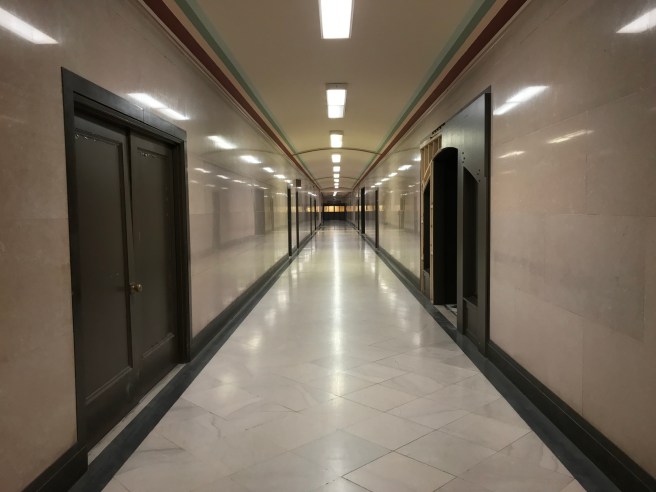
After a pick-me-up from Stella Good Coffee, we walked over to Pure Detroit — a retail shop and tour service staffed by knowledgeable Detroiters and also located within the Fisher Building. I asked both of the young employees about Exhibit 3000 and one had been there and enthusiastically recommended. Unfortunately, I got the sense that our enthusiasm was not shared by either of my traveling companions and the idea was put forth that I save visiting the techno museum for another day in Detroit.

OTHER DETROIT MUSIC
Of course, there’s more to Detroit’s music even then soul or techno and — as is my custom — I made a playlist of Detroit music to saturate my listening in. Detroit and nearby towns produced some great garage-punk and proto-punk (e.g. ? & the Mysterians, Death, The MC5, The Punks, The Stooges, and The UP!), jazz (e.g. Alice Coltrane, Donald Byrd, Pepper Adams, and Yusef Lateef — also, Detroit is home to the oldest continuously operating jazz club, Baker’s Keyboard Lounge, ); rhythm and blues (e.g. Andre Williams, Nathanial Mayer, and Nolan Strong); rock & roll like (e.g. Bill Haley and Del Shannon), and funk (e.g. Funkadelic).
BUHL BAR
Our last stop was at the Buhl Bar, which had been recommended to us by one of my sister’s friends. It is located in the Buhl Building — a 1925 Neo-Gothic skyscraper designed by the aforementioned Wirt C. Rowland and located across the street from the aforevisited Guardian Building. The architectural sculpture was, as with the Guardian Building, designed by Corrado Parducci. Unfortunately, the building was partially obscured by scaffolding. From 1928-1994, its top floor housed the exclusive Savoyard Club, to which we would no doubt not have been admitted. Our destination was a less-exclusive but quite pleasant bar located on the ground floor.
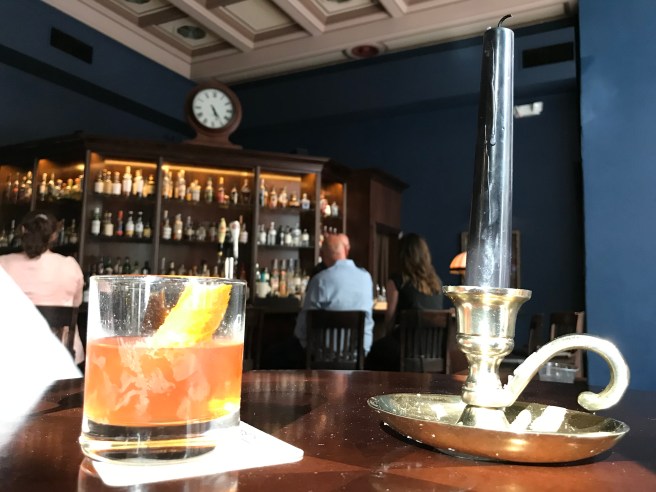
It was pleasantly quiet and relaxing inside — the way I prefer my bars be. It was nice to get off of our aching feet for a spell. We all drank different drinks — I had a couple of old fashioneds but had to pace myself as a drive back to Ann Arbor still awaited us — plus there was a jetlagged cat who was no doubt impatiently waiting for supper.

STUFF TO CHECK OUT NEXT TIME
Of course, since we only had a day in Detroit, we didn’t have time to see much. What we did, however, made me eager to see more. My favorite way to explore a city is to walk around aimlessly, letting smells, sounds, and sights dictate my route. Detroit’s pronounced automobile orientation might make that less feasible than it would be in similarly-sized cities. I would, however, like to spend more time wandering the streets of its residential neighborhoods.
ARCHITECTURE IN DETROIT
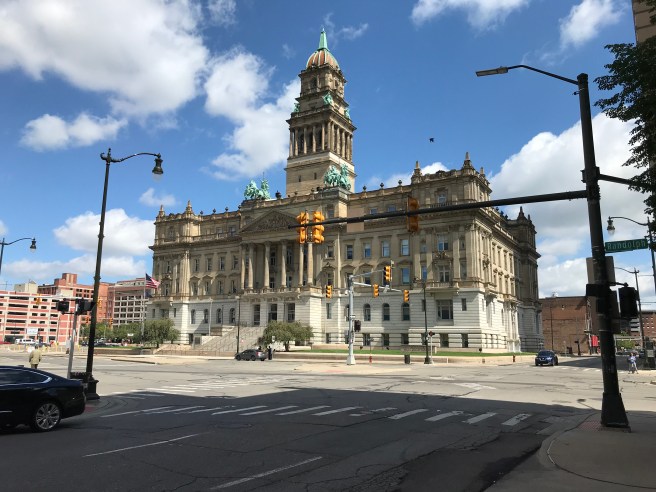
Despite the reputation for derelict ruins, Detroit remains home to many examples of architecture in good repair. In fact, for someone with only a short stay, Detroit’s architecture should be chief among its attractions. Detroit has numerous museums too, but even a medium-sized museum, when experienced properly, can easily eat up an entire day. Detroit was recently designated a “City of Design” by UNESCO — the first American city with that honor. In addition to the buildings we visited; Cadillac Place, the Cathedral of the Most Blessed Sacrament, the Fox Theatre, Old St. Mary’s, the Penobscot Building, St. Joseph Catholic Church, and the Sweetest Heart of Mary all look worthy of a closer look.
Other cultural amenities on my reserve itinerary include the Belle Isle Conservatory, the Charles H. Wright Museum of African American History, Crow Manor, the Dabls Mbad African Bead Museum, the Dequindre Cut Greenway, Detroit Historical Museum, Detroit Institute of the Arts, Detroit Opera House, Dossin Great Lakes Museum, Ford Piquette Avenue Plant, Fort Wayne, Main | Detroit Public Library, Museum of Contemporary Art Detroit, Pewabic Pottery Studio, the Spirit of Detroit, the Tuskegee Airmen National Museum, and much more (some of which is included on the map). Please feel free to leave your recommendations in the comments.
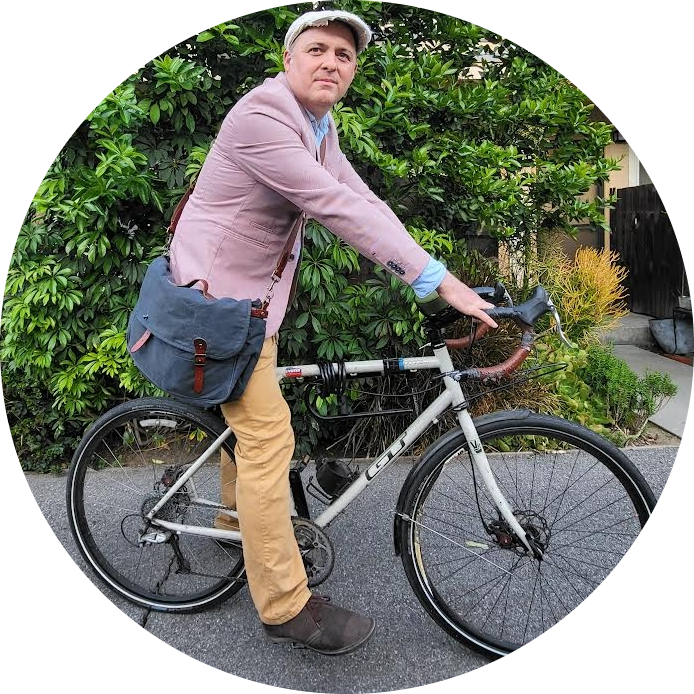




An interesting take on a place believed to be firmly embedded in the so-called Rust Belt (does anyone still use this term?).
LikeLiked by 1 person
I think people still use that term. My own mental map of the Midwest consists of the Great Lakes, the Rust Belt around them, and the Corn Belt around that (not sure whether or not anyone says “Corn Belt” but me).
LikeLiked by 1 person